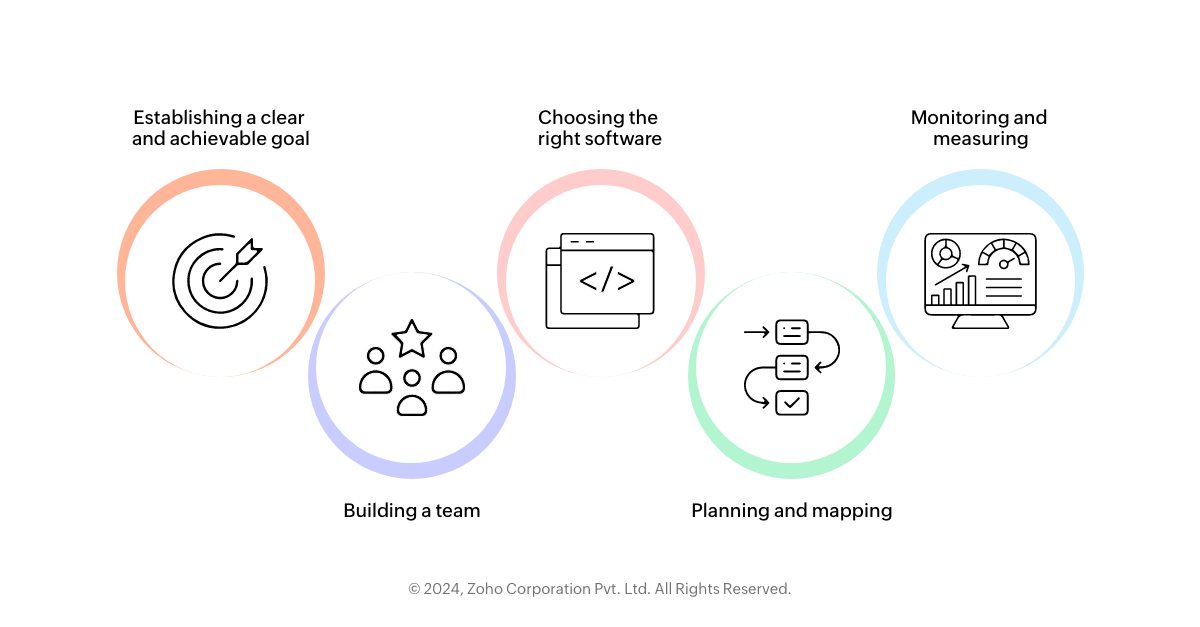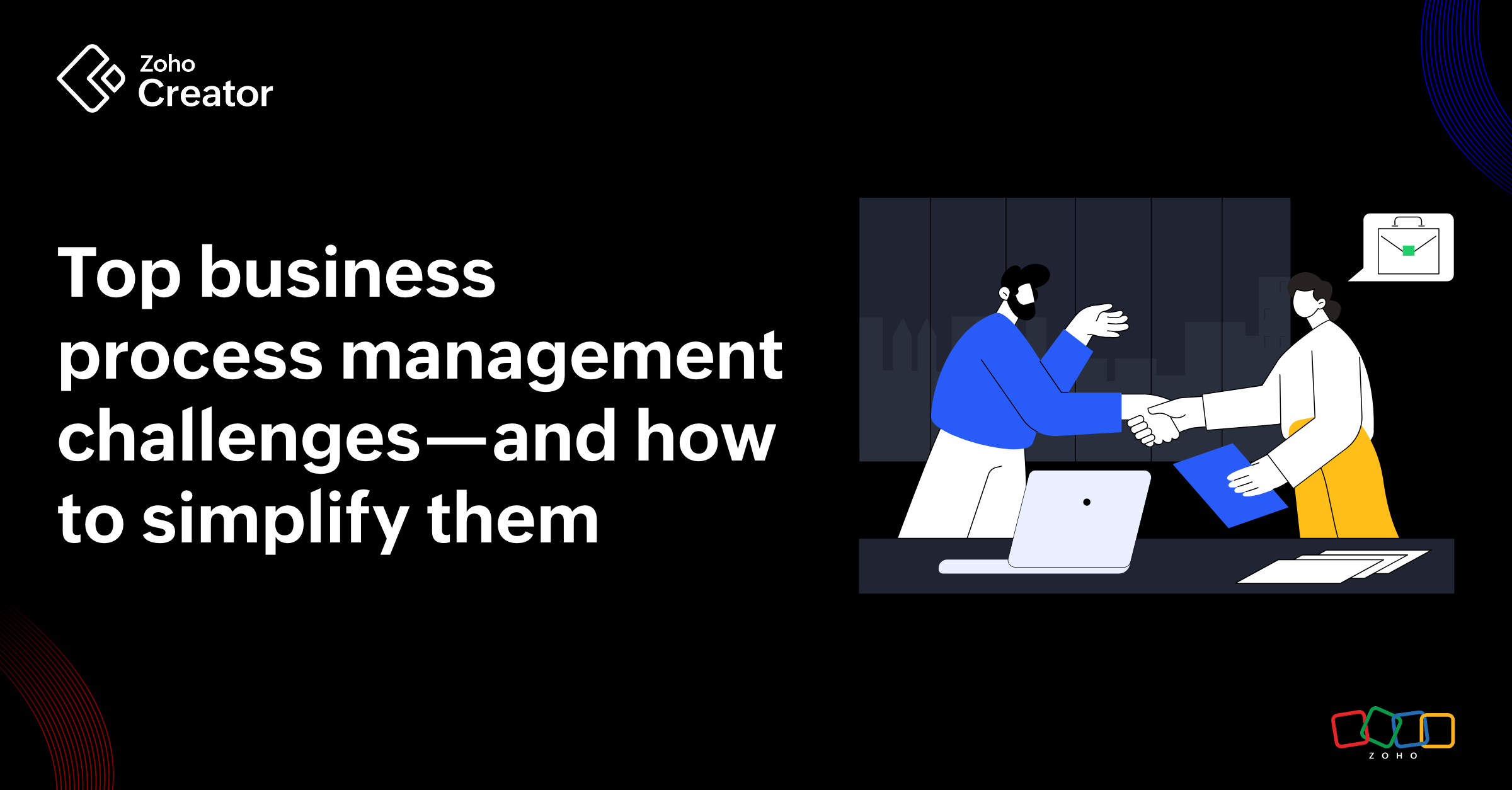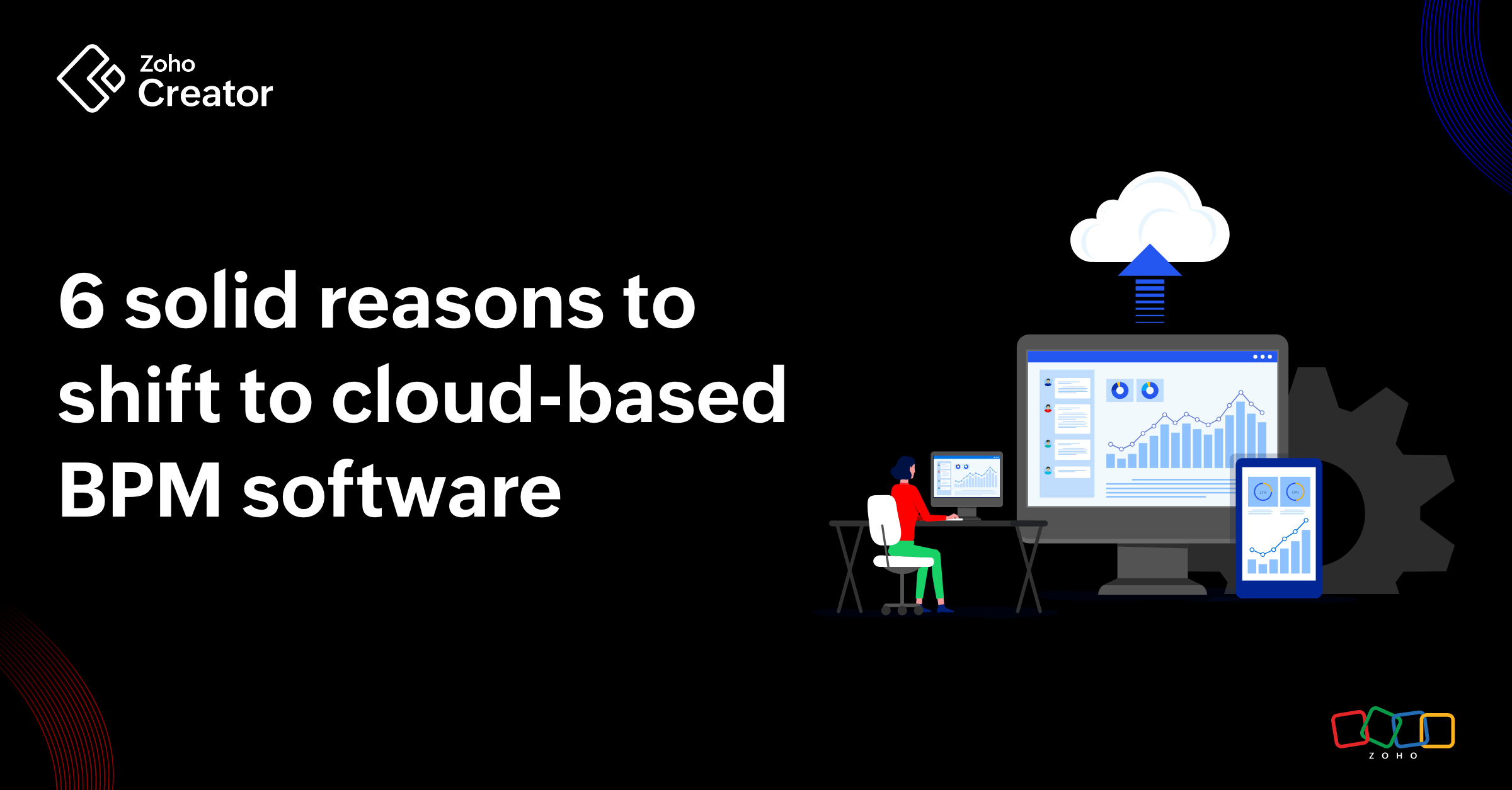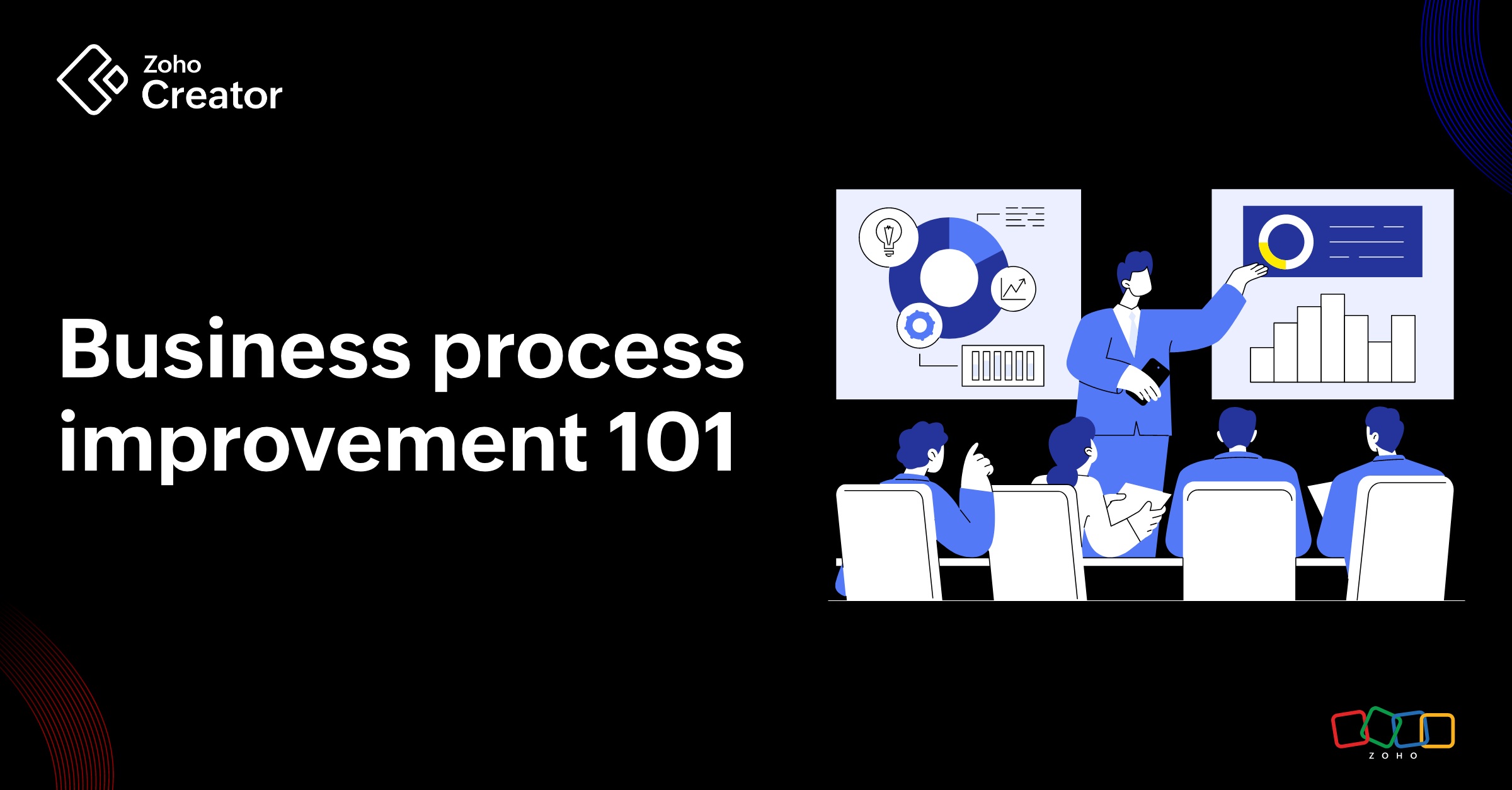- HOME
- Know Your Tech
- Your 5-step guide for BPM implementation
Your 5-step guide for BPM implementation
- Last Updated : September 20, 2024
- 406 Views
- 6 Min Read
Business process management (BPM) is mainly about understanding and improving how things work in organizations.
Over the years, BPM has evolved from simple process mapping to sophisticated systems that integrate technology, human resources, and organizational strategy. This guide will walk you through the steps to get started with business process management.
Implementing BPM isn’t just about picking the right software. A smooth and successful implementation involves setting goals, building a team, choosing the right tools, planning, monitoring, and more. So, let’s break it down step by step:

1. Establishing a clear and achievable goal
The first step when implementing BPM is to set your goal. Though it sounds obvious, the truth is, without a clear understanding of what you want to achieve, it’s easy to get lost in the details.
When setting goals, it's helpful to use frameworks like SMART (specific, measurable, achievable, relevant, time-bound) to ensure clarity and focus. Consider setting both short-term and long-term goals. Short-term goals might focus on quick wins that can build momentum, while long-term goals might involve more complex changes that require significant time and resources.
Whatever the goal is, it needs to be specific, measurable, and realistic, be it improving customer satisfaction or reducing costs and speeding up production time.
It's also important to get input from different departments and not just top managers, as they’ll have insights into what’s really going on at ground level. Once you’ve gathered this information, you'll be able to set a goal that everyone agrees on and understands.
2. Building a team
Business process management isn't something we can do alone. You will need a team of people with different skill sets to make it work.
When building a team, it's best to look for people who are not only knowledgeable but also open to change. BPM often involves shaking things up, and you'll need team members who are willing to challenge themselves and think creatively.
In addition to having the right skills, team dynamics are also important. Creating a culture of collaboration and open communication ensures that team members feel comfortable sharing ideas and feedback. Regular meetings, clear roles and responsibilities, and an environment that encourages innovation are key to a successful team.
Your team will also need a leader who can keep things on track, manage conflicts, and ensure that everyone is working towards the same goal. It's best to have a person who has strong communication skills and a good understanding of both business processes and the technology involved. Admins often fit well in this role due to their experience in coordinating complex initiatives.
Check out what are the essential features an admin needs in the BPM software.
3. Choosing the right software
Now that your goal and team are in place, the next step is choosing the right BPM software. There’s no one-size-fits-all solution, so you’ll need to consider your specific needs and budget. Some businesses might need a full-featured BPM suite, while others might get by with even a basic tool.
Before diving into the options, it's essential to conduct a thorough needs analysis. This involves understanding the specific requirements of your organization, such as whether you need workflow automation, new process modelling, real-time analytics, or integration with other systems.
While evaluating software, a few major things you have to think about are how it will integrate with your existing systems, how easy it is to use, and whether it offers the features you need. It's also better to consider the level of support and training available, as implementing processes and new software can be a learning curve.
4. Planning and mapping
Once the software is set, it’s time to start planning and mapping out your processes. This is where the real work begins, as you’ll need to take a close look at how things are currently done and identify areas for improvement.
Start by documenting your existing processes in detail, which involves creating flowcharts, SIPOC diagrams, or other visual representations. This will help you visualize complex processes and identify inefficiencies by showing how everything fits together.
Remember, never rush this step—getting a clear picture of your current processes is essential for making meaningful improvements.
After your processes are mapped out, you can start identifying bottlenecks, redundancies, and other issues. And after identifying them, you can start designing new processes that are more efficient and aligned with your goals. This might involve reassigning tasks, eliminating unnecessary steps, or automating certain parts of the process.
5. Monitoring and measuring
Once in place, it's important to monitor your processes closely to ensure they’re working as intended. This isn’t a one-time thing—it’s an ongoing process that requires regular check-ins and adjustments.
You can start by setting up key performance indicators (KPIs) that will help you measure the success of your new processes. These might include metrics like time to completion, error rates, customer satisfaction, or any other measure that’s relevant to your goals. Setting up dashboards can provide instant insights, allowing you to spot trends and issues quickly.
Monitoring should involve both quantitative and qualitative data. While KPIs will give you a clear picture of how things are going, it’s also important to gather feedback from employees and, if possible, from customers to see if the changes are having the desired effect.
Regular audits can also be beneficial in assessing the effectiveness of your processes over time and ensuring they remain aligned with organizational goals and compliance requirements.
If you find that certain processes aren’t working as well as expected, don’t step back from making adjustments. BPM is all about continuous improvement, so you can always tweak things as you go.
Common challenges and solutions
A process implementation plan comes with its own set of challenges. You might run into resistance from employees, or you might find that the new processes aren’t delivering the results you expected. Here are some common challenges and how to overcome them:
Resistance to change
This is one of the most common challenges in BPM implementation. People are often resistant to change, especially if they’ve been doing things a certain way for a long time. To address this, it's best to communicate the benefits of the new processes clearly and involve employees in the planning stages, so they feel a sense of ownership. Providing comprehensive training and support can also ensure a smooth transition and help them adapt to the changes.
Complexity
Sometimes BPM can become overly complex, especially if you’re dealing with multiple processes and departments. To avoid getting overwhelmed, start with small, manageable changes and gradually build on them. Keep the focus on your main goal, and don’t get bogged down in unnecessary details.
Lack of alignment
If your BPM efforts aren’t aligned with your overall business strategy, you’re likely to run into problems. Ensure that everyone involved understands how the new processes fit into the bigger picture and that they’re working towards the same goal. Regular strategy meetings and updates can help maintain alignment and adjust objectives as needed based on business growth.
Technology issues
Choosing the right software is vital, but even with the best tools, you might run into technical issues. It works best when you have a plan in place for troubleshooting and when the team has the training they need to use the software effectively. Additionally, never delay software updates, as they often contain important fixes to avoid problems. Updates also improve security and performance, which helps prevent issues from piling up.
Measuring success
It can be difficult to measure the success of BPM initiatives, especially if the benefits aren’t immediately apparent. To overcome this, focus on both short-term and long-term goals, and make sure you have the right metrics in place to track progress. Regularly reviewing and adjusting your KPIs ensures that they remain relevant and provide valuable insights into your BPM performance.
A clear path to successful BPM implementation
Successful process implementation can be a game-changer for your business, but it’s not something you can do overnight. It requires careful planning, a dedicated team, the right tools, and a commitment to continuous process improvement.
Patience is key, as significant changes and improvements often take time to materialize. After the initial implementation process, it's common for enthusiasm to fade. To keep the momentum going, encourage a culture of continuous improvement. Regular audits, continuous education, and staying updated with the latest BPM trends and technologies will help sustain your BPM efforts in the long term.
Remember, BPM isn’t just about making things more efficient. It’s about creating a more agile, responsive, and effective organization. And while there will be challenges along the way, with the right approach, you'll be able to overcome any issue eventually.
 Ann Elizabeth Sam
Ann Elizabeth SamHey! I'm Ann, and I work as a content writer at Zoho Creator. I'm exploring the SaaS world through various forms of content creation. Outside of work, I love dancing and would give up anything to read a good murder mystery.



